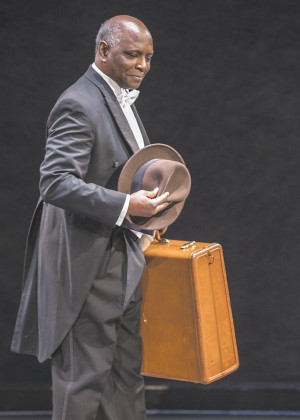Alonzo Fields, a black man born in 1900 and a native of Lyles Station, Indiana, was a witness to history. James Still’s play, Looking Over the President’s Shoulder tells the story of this remarkable man, the Chief Butler in the White House from 1933 to 1953, and how the world changed around him.
David Alan Anderson portrays Fields in this one-man show, offering up layers of character to a man who, in real life, would have been silent while the great, good, and not-so-good played their parts on the great world stage. Anderson, a legend on the stage in Indianapolis and elsewhere, carries the two hour production on a minimalist stage, easily shifting between the personal and professional in language and stance. In less capable hands, the play would be an interesting chronicle of the comings and goings over 20 years in the White House, but Anderson’s performance offers nuance and gesture that makes the history alive and intimate.
From Hoover to Truman, Fields served during one of the most tumultuous periods in American history. He wanted to be an opera singer, but took the butler gig at the White House in 1931 to pay the bills during the Great Depression. In 1933, he was named Chief Butler, serving Franklin and Eleanor Roosevelt, noting their efforts to overcome racial tensions in the White House. He was a witness to FDR’s reaction at the news of the attack on Pearl Harbor, Churchill’s visits (and eccentricities), listening to Maria Anderson sing, and watching the president’s declining health after his re-election for the fourth time. Fields notes that he was closer to Truman than the Roosevelts, finding him more natural with staff than the Roosevelts. After Eisenhower’s election in 1952, Fields left the White House to go to Boston in 1953, retiring after 21 years of service to tend to his wife. In 1960, he wrote his memoir, which is still used by historians to as a reference in biographies of the Roosevelts and Truman. Fields died in 1994.
Janet Allen directs this production of this version of Looking Over the President’s Shoulder, the third production the IRT has staged. With such a gifted combination of actor and director, the piece is often mesmerizing and the audience gets lost in the history living on the stage. Stagecraft is minimal, with less being more for telling such a big story. Robert M. Koharchik, scenic designer, Martin Chapman-Bowman as costume designer, and Michelle Habeck as lighting designer make the production look natural and effortless.
Looking Over the President’s Shoulder will be on the IRT Upperstage through May 6. Call 317-635-5252 or visit irtlive.com for performance information and ticket availability.



